|

 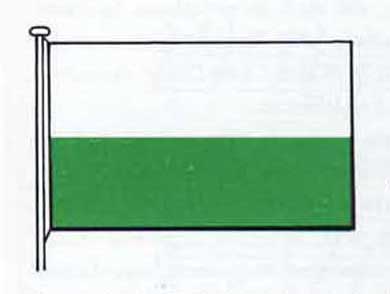 LANDESVERBAND USA
LANDESVERBAND USA  
 NEWSLETTER AND MAGAZINE
NEWSLETTER AND MAGAZINE 
DONAUSCHWABEN/GERMAN
CULTURE

 02/24/13 02/24/13

April May June 2011
Volume 6 Number 2



|



VISITING
AUTHOR/EDITOR ARTICLE
MAY
2011

PROST—ein
Toast!

Forwarded
From Trenton Donauschwaben

As we gather together at our Trenton Club or a Verband
Meeting (Trenton, Philly & the UGH in St. Louis) or a
Treffen and raise our glasses, one always hears those
familiar words ―Prost! for ―Cheers or
―Toast.
Did you know that the word ―Toast‖ supposedly
came from the English fact that they used spiced toast to
flavor wine and the notion that the person honored added
flavor to the party? Others report that toast was passed
around the table with the wine, each person took a drink but
it was the honored guest who took the last drink of wine and
eat the toast.
The German equivalent for the toast (Trinksprüche) became
―Prost! It is from the Latin ―Prosit, let it
be good. The term is usually used when drinking beer,
whereas ―Zum Wohl is used when drinking wine or
spirits, but never with whiskey! One should use ―Auf
Schottland (to Scotland) for making a toast with this fine
spirit.
Regardless, we always wish each other that healthy saying of
―Prost! as we enjoy each other‘s company in
fellowship, good health and cheer.
Source:
About.com and Tulleehee.com.


|

|

|
|
CLICK ON IMAGE FOR PDF VERSION OF CURRENT
LANDESRATFORUM NEWSLETTER JUNI 2011 |
|
Liebe
Leser im In- und Ausland, Freunde des Landesrates der
ungarndeutschen Chöre, Kapellen und Tanzgruppen auf aller
Welt!
2011 – Jahr der VOLKSZÄHLUNG - 15 Jahre Landesrat, 10
Jahre LandesratForum.
Heute erhalten Sie das neue LandesratForum JUNI 2011. Ich
hoffe das wir wieder Ihren Geschmack getroffen haben und es
ein schönes Exemplar geworden ist . Dieses Jahr findet die
Volkszählung in Ungarn
statt. Ein wichtiger Abschnitt im politischen Leben der
Ungarndeutschen. Bitte beachtet die Artikeln darüber aus
Seite 9 und Seite 14 darüber. Ebenfalls in diesem Jahr feiern
wir zwei Jubiläen, einmal 15 Jahre Landesrat und dann 10
Jahre LandesratForum. Sollten Sie Ideen wie wir das feiern könnten,
oder wie wir das Forum besser und feierlicher gestalten könnten,
oder was wir hineinschreiben sollten, so bitte ich Sie teilen
Sie uns das alles mit. Wir freuen uns auf jede konstruktive
Kritik aber natürlich auch auf jede positive Meldung.
Ausserdem finden Sie Aufrufe, einer für das
HARMONIKALAGER, einer für die Serie "FAMILIENMUSIK"
und ein weiterer für die TANZQUALIFIKATIONEN im Jahre 2011.
Auch in diesem Jahr sind wir wieder auf Ihre großzügige
Hilfe angewiesen. Unterstützen SIE uns bitte daher mit einer
Spende dass wir unseren Kulturauftrag auch weiterhin ausführen
können.
DAS LANDESRATFORUM IST KOSTENLOS - ABER NICHT UMSONST
|

|



VISITING
AUTHOR/EDITOR ARTICLE
MAY
2011

 |
|
Deutsche
Sprach Schule
|
|
ADULT
LANGUAGE SCHOOL
NEW
INSTRUCTORS TO THE TEAM
|
|
 |

Forwarded
From Trenton Donauschwaben

The Adult Language Program continues to grow! We are happy
to report an increase in enrollment and we welcome the
addition of our second instructor, Ryan Kramer. Ryan‘s
knowledge of the language and enthusiasm for the culture
makes him a very valuable addition to our program. His
Palanka ancestoral surnames include; Klespies, Kornfeld,
Schwendemann and Burg. Ryan is a foreign language student at
the prestigious University of Pennsylvania. Welcome, Ryan
(standing in the right hand photo above)!
Ryan, along with Christa Tindall Pullion, encourages anyone
interested in the German language and culture to come join
us on Wednesday nights from 7-8 pm. All are welcome; hope to
see you there! In addition, Christa will be working for ETS
this summer grading the German Praxis exam for teacher
certification—Good Stuff Christa!


|

|



VISITING
AUTHOR-ARTICLE
APRIL
2011

EASTER
BREAD RECIPE
Forwarded
by United Donauschwaben Milwaukee

|
EASTER
BREAD RECIPE
|
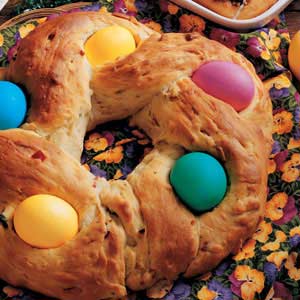
|
|
INGREDIENTS
|
3
cups flour
1
package yeast
½
cup sugar
¾
teaspoon salt
½
cup lukewarm milk
½
cup butter
2
eggs
Grated
lemon rind
1
egg yolk (save egg white for glaze)
|
|
DIRECTIONS
|
1.)
Melt the butter and add milk to make
it
lukewarm. Soak the yeast in ¼ cup
lukewarm
water with a teaspoon of sugar.
When
yeast is bubbly, add it to the flour
with
all the other ingredients, except the
one
egg white.
2.)
Stir together until moistened. Wait a
few
minutes, then work the dough until it
is
very smooth and doesn’t stick. It
should
come
off the sides of the bowl. Dust top
with
flour.
3.)
Cover with a clean dish towel and let
it
rise until doubled in size. Place on a
floured
board and work into a smooth
ball.
Divide into three equal portions; let
them
rest about ten minutes, and then
shape
them into three 24 inch ropes.
4.)
Braid the ropes and place the braid
on
a large greased cookie sheet (shaping
it
into a wreath/ring). Cover and let rise
another
15 to 20 minutes. Preheat the
oven
to 375˚ Fahrenheit.
5.)
Brush wreath with the reserved egg
white
and bake for 30 to 45 minutes.
To
make it special, color five hardboiled
eggs.
When wreath is completely cooled
hollow
out five equally spaced spoon
sized
holes in the wreath and put the
colored
eggs into them.
|

|
|

|



VISITING
AUTHOR/EDITOR ARTICLE
APRIL
2011

SEMMELKNÖDEL
RECIPE

Forwarded
From Trenton Donauschwaben

|
Semmelknoedel
(Bread
Dumplings)
|
|
These
Bavarian large dumplings accompany
roast
pork or game dishes, any meat with
gravy,
or with mushrooms in a creamy sauce.
Serve
one dumpling alongside your dish, and
cover
with a little gravy.
|
|
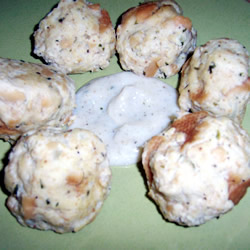
|
|
Ingredients
|
1
(1 lb.) loaf stale French bread, cut into 1 inch
cubes
1
cup milk
2
tablespoons butter
1
onion, finely chopped
1
tablespoon chopped fresh parsley
2
eggs
1/2
teaspoon salt
1
pinch ground black pepper
1/2
cup dry bread crumbs (optional)
|
|
Directions
|
·
Place the bread cubes into a large bowl.
·
Heat the milk until it starts to bubble at the
edges,
then
pour it over the bread cubes.
·
Stir briefly to coat the bread.
·
Let soak for 15 minutes.
·
Meanwhile, melt the butter in a skillet over
medium
heat.
·
Add the onions; cook and stir until tender.
·
Stir in the parsley, and remove from the heat.
·
Mix into the bowl with the bread along with the
eggs,
salt and pepper.
·
Use your hands, squeezing the dough through your
fingers
until it is smooth and sticky.
·
Bring a large pot of lightly salted water to a
boil.
The
water should be at least 3 or 4 inches deep.
·
When the water is boiling, make a test dumpling
about
the size of a small orange or tangerine, by
patting
and cupping between wet hands.
·
Gently drop into the boiling water. If it falls
apart,
the
dough is too wet. In this case, stir some bread
crumbs
into the rest of the dumpling batter.
·
Form the remaining dough into large dumplings,
and
carefully drop into the boiling water.
·
Simmer for 20 minutes, then remove to a serving
plate
with a large slotted spoon.
·
They should come out soft, spongy and delicious!
|

|

|

|
|
CLICK ON IMAGE FOR PDF VERSION OF CURRENT
LANDESRATFORUM NEWSLETTER
|
|
Liebe
Leser im In- und Ausland, Freunde des Landesrates der
ungarndeutschen Chöre, Kapellen und Tanzgruppen auf aller
Welt!
2011 – Jahr der VOLKSZÄHLUNG - 15 Jahre Landesrat,
10 Jahre LandesratForum.
Heute erhalten Sie das neue LandesratForum Mai 2011.
Ich hoffe das uns wieder Ihren Geschmack getroffen hat und
ein schönes Exemplar geworden ist . Dieses Jahr findet die
Volkszählung in Ungarn
statt. Ein wichtiger Abschnitt im politischen Leben der
Ungarndeutschen. Bitte beachtet den Aufruf auf SEITE 1 des
Forums. Ebenfalls in diesem Jahr feiern wir zwei Jubiläen,
einmal 15 Jahre Landesrat und dann 10 Jahre LandesratForum.
Sollten Sie Ideen wie wir das feiern könnten, oder wie wir
das Forum besser und feierlicher gestalten könnten, oder
was wir hineinschreiben sollten, so bitte ich Sie teilen Sie
uns das alles mit. Wir freuen uns auf jede konstruktive
Kritik aber natürlich auch auf jede positive Meldung.
Ausserdem finden Sie Aufrufe, einer für das
HARMONIKALAGER einer für die Serie "FAMILIENMUSIK"
und ein weiterer für die TANZQUALIFIKATIONEN im Jahre 2011.
Auch in diesem Jahr sind wir wieder auf Ihre großzügige
Hilfe angewiesen. Unterstützen SIE uns bitte daher mit
einer Spende dass wir unseren Kulturauftrag auch weiterhin
ausführen können.
DAS LANDESRATFORUM IST KOSTENLOS - ABER NICHT UMSONST
|

|



VISITING
AUTHOR/EDITOR ARTICLE
MARCH
2011

2011
UGH SCHNITZEL NIGHT RECIPES

Forwarded
From UGH

Recipes
Offer a Taste of German-Hungarian cooking
March
2011
Members of the United German-Hungarians club in Horsham
Township prepare dishes from their new cookbook, Mahlzeit,
on Thursday evening.
Marlene Fricker served this salad as an accompaniment to the
chicken paprikas. The original recipe calls for cucumber,
but Fricker says you can use a juicy lettuce such as iceberg
instead.
If
you can't make it to Schnitzel Night at the United German
Hungarians, you could make your own schnitzel at home. The
club uses pork, but you could use veal instead. Veal cutlets
are readily available at most supermarkets, but if you want
to use pork, you'll probably have to cut your own cutlets
from a boneless loin roast (or you could even use thin pork
chops, cutting away and bone and fat).
|
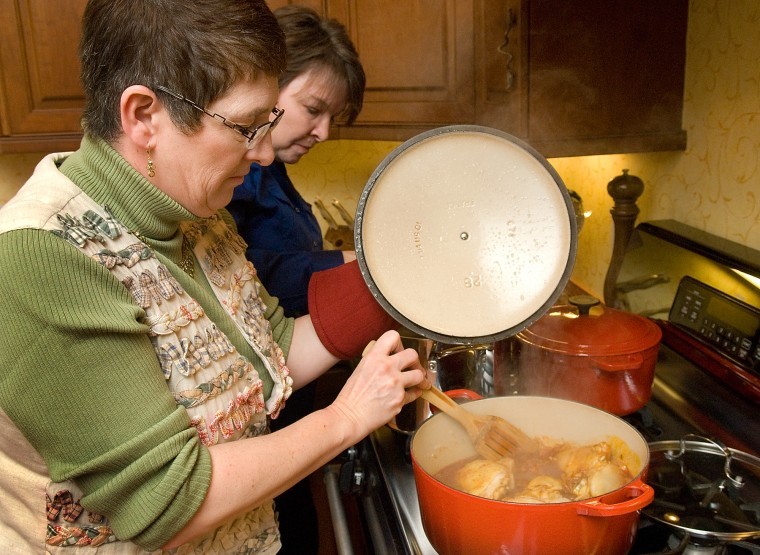
|
|
Lettuce
Salad
|
|
Here Marlene Fricker of
Horsham (left) prepares
chicken paprikas as her
sister-in-law, Lisa Fricker
(background), makes Nockerl.
|
|
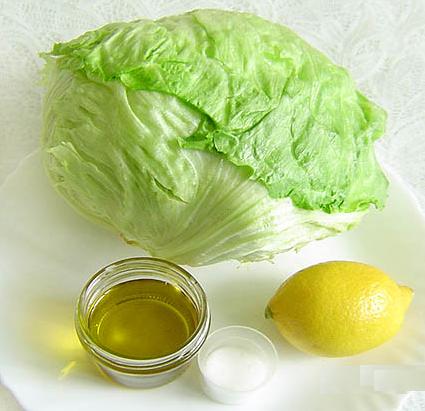 |
|
|
Ingredients
|
Iceberg
lettuce
1
small onion
1
tablespoon vinegar
2
heaping tablespoons sour cream
1/2
teaspoon salt
Paprika
as desired
|
|
Directions
|
Tear
off enough leaves from the lettuce to
make salad for four. (Reserve the
remainder for another use.)
Finely
slice onion.
Mix
the lettuce and onion with the remaining
ingredients in a bowl.
Add
additional salt if needed.
Garnish
with paprika.
|
| Additional
Information
|
Makes
4 servings.
Note:
This recipe may be doubled or tripled;
however, use vinegar sparingly.
Recipe
by Maria Kredler from "Mahlzeit,"
the cookbook of the United German
Hungarians
|
|
| Wiener
Schnitzel
|

|
|
|
Ingredients
|
8
pieces of veal or pork, pounded thin to
1/4 inch
Salt
and pepper to taste
1
cup flour, or more, if needed
3
eggs, beaten
2
tablespoons milk
1
1/2 cups plain bread crumbs, or more if
needed
Canola
oil for frying
|
|
Directions
|
Salt
and pepper each cutlet.
Beat
eggs and milk together.
Place
flour, egg mixture and bread crumbs in
three separate plates.
Dredge
each piece of meat into the flour, shake
off the excess, then dip into the egg
and then into the breadcrumbs.
Fry
until golden brown on each side over
medium heat.
|
| Additional
Information
|
This
is a simple version of a German classic
dish. It is found on the menu of most
German restaurants. Serve with a
dumpling or potato dish.
Recipe by Maria Martin from "Mahlzeit,"
the cookbook of the United German
Hungarians
|
|


|


|



VISITING
AUTHOR-ARTICLE
MARCH
2011

Handwerker
Berufe
(craftsman
occupations)
Banater
Handwerker Berufe in den Jahren 1790-1944
und
Geschicklichkeiten der Donauschwaben
von
Catherine Grosskopf
Forwarded
by American Aid Society, Chicago

Ausser den Bauern gab es
in den Banater Dörfern viele Handwerker,
die nötig waren für das Auskommen einer Gemeinde.
Meistens hatten die Handwerker ausser ihrem Beruf,
etwas Feld nebenbei, das sie selbst verarbeiteten für den
Eigenverbrauch. Ein Gemüsegarten gehörte zu jedem Haus.
Zugegen waren folgende Handwerker:
*Bäcker-Zucker-backer,
Bildhauer, Dreher, Buchbinder, Buchdrucker, Bürstenbinder,
Drechsler, Färber, Fassbinder, Fleischhauer, Gerber,
Glaser, Goldschmied, Huf & Wagenschmied, Hutmacher,
Kammacher, Kepernikschneider, Klempner, Korbmacher,
Kürschner, Lebzelter Konditor, Mantelschneider, Maurer,
Maschinenschlosser, Mechaniker, Müller, Pelzschneider,
Pantoffelmacher, Rasierer-Friseur, Rauchfangkehrer, Riemer,
Sattler, Schnappsbrenner, Schmied, Schneider/ rinnen,
Spengler, Schuhmacher, Seifensieder, Seiler, Siebmacher,
Steinmetz, Stiefelmacher, Tapezierer, Tischler, Uhrmacher,
Wagner, Weber, Wollkrempler, Wollspinner, Zementwarenhersteller,
Zirnmermaler und Zimmermann.
Unter den Frauen gab es Netzerinnen, die Fischnetze und Vorhange
für die Hausfenster herstellten. Strickerinnen, die das
maschinelle Weben der Strickkunst erlernten und Westen, Umhängetücher
und dergleichen anfertigten. Das Handarbeiten
und Näben der Frauen war nicht nur Begehrenswert, sondem
auch eine Pflicht, weil sie eine Lebensnotwendigkeit für
den Alltag waren. Die Grundlagen der Handarbeit wurde schon
in der Volksschule erlernt. Wer weiteres Interesse und
Talent hatte ging zusätzlich, privat in die
Handarbeitsschule oder man besuchte einen Nähkurs. Die
Handarbeit war eine Konkurrenz
unter den jungen Mädchen, denn sie waren bemüht
eine schöne Aussteuer in die Ehe mitzubringen. In den
Wintermonaten wurden diese meistens verrichtet; vorallem
abends wenn sich die Jugendlichen in den Häusern der Mädchen
trafen, wo auch die Burschen später zur Geselligkeit, hinzukamen.
Es war eine Zeit sich einander kennen zu lernen. Die
Feldarbeit war getan, und man hatte genug Zeit dazu. Mädchen
heirateten damals meist unter zwangig Jahren, Burschen
waren gewöhnlich ein paar Jahre älter und galten als heiratsfähige
Männer nachdem sie zwei Pflichtjahre Dienst im Militär
geleistet hatten.
Verheiratete Frauen beschäftigten sich hauptsächlich mit
dem Wollspinnen und stricken der Strümpfe, Handschuhe, Umhängetücher
und Schals, denn diese wurden von der ganzen
Familie benützt. Ein jedes Haus hatte einige Schafe, die
das ganze Jahr auf der Weide, vom Wächter gehütet, verbrachten
und nur über die Wintermonate daheim, im Stall waren.
Die Schafe wurden im Frühjahr geschoren. Als Kinder beobachteten
wir das gerne, denn der Schafhüter tat dies im Hofe
des Schafeigentumers. Die Tiere waren danach erleichtert
und sprangen übermütig im Hofe herum. Die Wolle wurde zuerst
gewaschen, zum Wollkrempler gebracht, welcher diese spinnbereit
machte, wonach sie von den Frauen gesponnen wurde.
Der Wollfaden wurde von der Spule auf einer Haspel zu Strängen
gemacht. Danach hat man diese selbst gefärbt und zu
einem Knaeul aufgewickelt. Somit war die Wolle im Herbst strickbereit.
Frauen und Mädchenvereine strickten im Zweiten Weltkrieg
Handschuhe und Socken für das deutsche Militär; sie
schickten Pakete an ihre Lieben in der Feme.
Die Pflanzung von Flachs und Hanf waren zur Herstellung der
Leintücher, Plane und dergleichen gedacht. Die Hanf und Flachsverarbeitung
war eine mühevolle, schwere Arbeit. Nach der
Ernte, mussten die langen Stengeln zum aufweichen in das
Wasser (die Kaule) für einige tage gelegt werden. Erst dann
wurden sie auf dem
Holzbock weich geschlagen, um den Hanf zu
reinigen. Der Geruch war so ekelhaft, dafe es einem übel
wurde davon; wir Kinder blieben nie in der Nähe und suchten
uns alsbald einen anderen Spielplatz. Nachdem man den Hanf
zu einem Faden gesponnen hatte, gab man ihn an die Weberei,
zur weiteren Verarbeitung.
Es gab viele kunstvolle Anfertigungen von Handarbeiten, womit
sich die Frauen vielfältig beschäftigten. Die Aussteuer:
Leintücher, Federkissen, Strohsäcke, Handtücher, Tischdecken
u.a. war eine wichtige Fürsorge der Mütter, die ihrer
Tochter womöglich einen finanziell besser stehenden Bräutigam
zuführen könnte. Wieviel einer in die Ehe mitbrachte war
ebenso ein wichtiger Punkt bei den Donauschwaben. In späteren
Jahren hat sich die Handarbeit weiter entwickelt und wurde
Jahrelang von den in der alten Heimat zurück gebliebenen
Frauen als Erzeugnis auf dem schwarzen Markt zum Verkauf
benützt. Man tat alles, um die Armut zu überbrücken in
schweren, hilflosen Zeiten. Die Handarbeit war ein Ersatz, sowie
eine Ergänzung ihres Einkornmens. Handarbeiten wurden
auch für Naturalien eingetauscht. Viele Landsleute brachten
solche Kunststücke mit von einem Besuch in der alten
Heimat. Diejenigen, die durch die Flucht nach Österreich und
Deutschland kamen, erlernten weitere Handarbeiten und nützten
sie ebenfalls um die Not zu tilgen. Manche Frauen strickten
daheim für Fabriken um den Lohn. Meine Mutter auch
- es war ein mühevolles, schwer erarbeitetes Geld. Für viele
aber ist die Handarbeit ein Zeitvertreib, und die "Liebe"
ihres Lebens
geblieben.
Hier will ich einige Handarbeiten nennen: stricken, haekeln,
netzen, schiffeln,
gabeln, sticken, klöppeln, knüpfen. Das Ausnahen
von Taschentücher, Handtücher, Tischdecken und
Wandschoner wurden von alien für den Eigengebrauch gemacht.
Natürlich gab es dann noch Personen, die die Handarbeitsmuster
auf das Material abdruckten. Das Schlingen der
Unterröcke war eine besonders mühsame Arbeit und wurde später,
in den vierziger Jahren, mit Nähmaschinen geschlungen.
Diejenigen, die keine Zeit oder Talent dazu hatten, überliessen
die Arbeit, um den Lohn, für andere. Geschlungene Unterröcke
für erwachsene Mädchen, die zu den Trachten gehörten,
waren unentbehrlich, denn zujeder Tracht gehörten drei
gestickte, steif, gestarkte Unterröcke, dazu ein ganz
kurzer (Hansl) um die Hüften, damit die Tracht recht voll
war.
Während der Kriegsjahre (vierziger Jahren) versuchten die Frauen
den Kindern warme Lischenschuhe aus Maislischen zu
machen. Obwohl sie sehr anschmiegsam und warm am Fuss
waren, hielten sie die Strapazen des Gehens nicht lange aus
und der Versuch wurde wieder aufgegeben. Die Schwaben waren
bestrebt, eine jede Kleinigkeit nützlich und brauchbar zu
machen. Alles was den Siedlern unterkam wurde ausgetüftelt
und für irgend einen Zweck anwendbar gemacht. Irgendwie,
irgendwo oder irgendwann, wird man einen Nutzen davon
haben, sagten sie. Schliesslich kamen sie aus deutschen Landen,
wo man der Armut und Hungersnot entfliehen musste.
Der Dreissigjährige Krieg, (1618-1648) der 3/5 der Bevölkerung
(10 Millionen) deutsche Opfer kostete vernichtete Macht und
Wohlstand in Deutschland. Die Ohnmacht des Deutschen
Reiches, das Einmischungsrecht der Schweden und
Franzosen wurden fest gelegt. Diese politischen Ereignisse
liessen den Wiederaufbau des Landes und der Bevölkerung im
schwachen Zustand. Die Ausnützung der Bürger von
den Adeligen war Grund genug zur Auswanderung, wo man
vielleicht eine bessere Zukunft hätte. Als sie ihr Land verliessen,
zum Verdruss der Adeligen, mussten sie sich oft abkaufen,
vor der Auswanderung. Eine Rückkehr in ihre alte Heimat war
ihnen verboten. Sie waren bestrebt einen Erfolg aus
ihrer Not zu machen. Die Deutschen hatten gelernt der Not
Herr zu werden. Wie ein Sprichwort so schön sagt "Die Not
macht erfinderisch". Sie nahmen ihre Gewandtheit mit
ins Banat, wo
sie einen Neubeginn machten. Die Geschicklichkeit, Fleiß
und Sparsamkeit sind Eigenarten der Donauschwaben, die
das Banat zur Kornkammer Europas machten. Sie dürften auch
zum Neid der anderen Völker geworden sein.
In unserem Dorf gab es - so änhlich war es in anderen, kleineren
Banater Dörfern auch, denn alle waren Vorschriftsmäßig
angelegt und sie pflegten, mit kleinen Verschiedenheiten, diesselbe
Lebensweise. Es gab etwa: Ein halbes Dutzend Krämer,
ein großes Wirtshaus und einige kleine Wirtshäuser, eine
Bibliothek, eine Wochenzeitung, eine Bank, eine Apotheke,
eine Holzhandlung, zwei Mühlen, eine Molkerei, ein Schnittwarengeschäft,
einige Fotografen, eine Bäckerei und eine Zuckerbäckerin.
Fast alle von den oben erwähnten Handwerker
waren ebenfalls anwesend. Zusätzlich gab es einen
Schützenverein, Leichenverein, Spar und Vorschußverein,
Lese und Fortbildungsverein, Sparkassa, Bauernverein,
Handels und Gewerbeverein, Gesangverein, ein Frauen und
katholischer Jugendverein, ein Kirchenchor, zwei Blaskapellen
und eine freiwillige Feuerwehr.
Weiter waren ein rumänischer und ein deutscher Arzt, ein deutscher
Tierarzt sowie eine Hebamme im Dorf, die Rumänin und
sehr beliebt war bei alien. Es gab zwei deutsche
Volksschulen, eine rumänische, sowie eine serbische. Alle
wurden in ihren
Sprachen unterrichtet. Wir hatten deutsche Lehrer und hatten
zweimal wöchentlich je eine Stunde, rumänischen Unterricht.
Der Kindergarten war gemischt und wurde von einer
deutschen (1936-1944) Kindergärtnerin Frl. Szimits, Tochter
von dem bekannten Banater Dichter, geleitet. Ihre Helferin
war Rumänin. Frl. Szimits war gleichzeitig Organistin in
der deutschen Kirche und verblieb nach dem Zweiten Weltkrieg
in der alten Heimat, wo sie weiterhin ihre Arbeiten bis zu ihrem
Lebensende verrichtete.
Wer höhere Schulen besuchen wollte ging in die Stadt nach
Temeschburg. Die Banatia, ein Gymnasium oder in das
Notre-Dame Klosterschule Gymnasium und andere boten ein
Studium in vielen Fächern an. Die Schüler von den
umliegenden Dörfern fuhren täglich mit dem Zug in die
Stadt zur Schule. Von unserer Ortschaft, (Kleinbetschkerek)
waren es nur 17
km bis dahin. Da die Mehrheit in unserer Gemeinde Deutsche
waren und dem römisch katholischen Glauben angehörten,
war auch die deutsche Kirche die größte, mit einem
ungewöhnlich hohen Turm, wofür die Einwanderer extra
bezahlten. Die Rumänen und Serben waren griechisch Orthodox
und verschieden voneinander. Eine jede Kirchenge-meinde
hatte ihren eigenen Geistlichen, wo sie auch
gesell-schaftlich zusammen kamen. Jede Volksgruppe pflegte
ihre eigene Kultur. Mischehen gab es keine oder nur
selten. So lebte man
harmonisch bis 1944 nebeneinander. Von 2357 Einwohnem im
Jahre 1944 waren 2/3 davon Deutsche. Am Dorfrand lebten
auch einige Zigeunerfamilien. Die Gendarmerie (polizei) und
das Gemeindeamt (Burgermeisterei) waren von Rumänen verwaltet.
Der letzte Bürgermeister war ein Deutscher. Als die Russen
einmarschierten, (1944) kam er nach Russland und kehrte
nie wieder zurück. Es gab ein Trommelmann (Kleinrichter)
im Dorf, der auf deutsch und rumänisch, die Neuigkeiten täglich
ausrief.
Wie schon erwähnt waren die Banater Dörfer, von den
Habsburgern in Wien geplant und von Graf Floribund Mercy, dem
ersten Govemeur im Banat, eingerichtet worden. Er plante
die Ausführung der Ansiedlungen und war bestrebt einen
Erfolg durch verschiedene Massnahmen des Einkommens
zu ermöglichen. In jedem Hofe waren einige Maulbeerbäume
angepflanzt. Nach der Reifezeit wurden die Maulbeeren zu
Schnaps gebrannt für den Eigengebrauch. Die Seidenraupenzucht
bot eine zweite Möglichkeit des Einkommens. Diese währte
nicht lange in Kleinbetschkerek, denn sie nahm viel Zeit
in Anspruch wofür der Ertrag zu gering war. In Temeschburg
war eine Seidenfabrik, wo die Kokons abgeliefert wurden; obzwar
die Seidenraupenzucht in Kleinbetschkerek nicht lange
anhielt währte dagegen das Schnapsbrennen bis heute. Die
Felder von Kleinbetschkerek eigneten sich für Mais, Getre-ide
und Tabak. So gab ausser den Großbauern auch Schweinezüchter
und Tabakbauern.
Unsere Ortschaft Kleinbetschkerek, wurde während der Regierungszeit
Joseph 11, (1782 -1788) Sohn der Kaiserin Maria
Theresia, im Dritten Schwabenzug (1785) angesiedelt. Die
Siedler kamen aus deutschen Landen und sollten eine neue
Lebensweise und bessere Wirtschaftsformen einführen. Sie
taten es, die Schwaben und es entwickelte sich im Banat ein
neuer, deutscher Volksstamm. "Donauschwaben". !Den
Namen bekamen
sie später, denn die don lebenden Volker nannten
sie die Schwaben, obwohl sie aus verschiedenen Teilen
Deutschlands kamen).
Wir wollen unser Banat von einst, sowie unsere verstorbenen
Angehörigen in guter Erinnerung behalten.

|
|
|
*Teils
aus "Baroti, Perjamosch" Ferch,
Verwaltungsbericht 1911
Waldner
|

|

|



VISITING
AUTHOR/EDITOR ARTICLE
MARCH
2011

FRANKFURTER
KRANZ

Forwarded
by Chicago Donauschwaben

| FRANKFURTER
KRANZ |
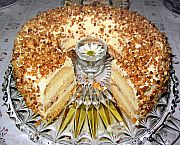 |
|
| INGREDIENTS |
scant
1/2 cup butter (about 7 tablespoons)
3/4 cup granulated white sugar
3 large eggs
grated rind of 1/2 lemon
3/4 cup sifted all-purpose flour
1/3 cup cornstarch
2 teaspoons baking powder
1 1/2 recipes Butter Cream Frosting
(recipe follows)
praline or Krokant, made with 1
tablespoon butter, 1/4 cup sugar
1 cup blanched and chopped almonds or
hazelnuts
|
|
MIXING
AND
BAKING
DIRECTIONS
|
Pre-heat
oven to 350F. Cream butter with sugar
until light and fluffy. Add eggs, one at
a time, beating well after each
addition. Mix in grated lemon rind. Sift
flour again with cornstarch and baking
powder. Gradually stir in butter-egg
mixture until thoroughly blended. Butter
and flour a cake ring mold and tap out
excess flour. Pour batter into pan. Bake
in the lower half of oven for 45 minutes
to 1 hour, or until cake tests done. A
toothpick inserted in the center should
come out clean. Cool in pan until cake
shrinks away from the sides of the pan.
Invert cake onto rack and cool
completely. While cake is cooling,
prepare butter cream filling. To make
praline topping or Krokant, place the
butter and sugar in a frying pan over
low heat, and stir constantly until the
sugar is lightly browned and melted.
Stir in nuts and pour onto a greased or
buttered flat serving plate. When cold
and hard and set, crack praline topping
into small pieces.
|
|
FINAL
PREPARATIONS
|
Cut
cake into 3 layers. Spread 1 cup of
butter cream filling onto bottom and
middle layers, saving enough to cover
outside of cake. Stack layers and spread
rest of filling on top and all sides.
Sprinkle praline topping or Krokant on
top and sides of cake. Refrigerate at
least 24 hours before serving.
continue - the filling!
|
|
| German
Butter Cream Filling Recipe |
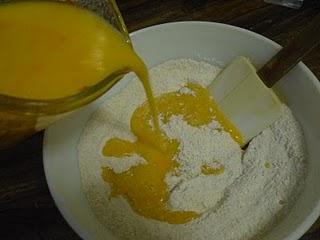 |
|
|
INGREDIENTS
|
6
large egg yolks, lightly beaten (room
temperature)
3/4 cup granulated white sugar
1/2 cup water
1/2 tablespoon cornstarch
1 1/4 cups softened butter
flavoring, to taste
|
|
MIXING
DIRECTIONS
|
Over
low heat, cook sugar, water and
cornstarch, stirring until dissolved.
Bring to a boil, and stir, until mixture
forms a soft ball when dropped in cold
water (238F on candy thermometer). VERY
slowly, stirring constantly, in a very
thin stream, pour boiling hot syrup in.
If you add the boiling syrup too
quickly-it will scramble the egg yolks,
so take your time barely a thread of
syrup at a time, while stirring
vigorously. Beat until mixture cools and
is smooth. Cool completely. Beat
softened butter into the cooled creme,
adding your favorite flavoring - 3 to 4
tablespoons rum, arrack, kirsch or fruit
liquors; or 1 tablespoon vanilla
extract; or 2 1/2 oz. melted and cooled
semi-sweet baking chocolate; or 1/2 cup
ground hazelnuts; or a combination of 1
1/2 oz. melted and cool semi-sweet
baking chocolate mixed with 2 teaspoons
instant coffee dissolved in 2 teaspoons
of boiling water, for a mocha flavor.
For cocoa butter creme, beat in 4
tablespoons cocoa powder and vanilla
sugar.
|
|
|

|
Recipe
for Pecan-Krokant
|
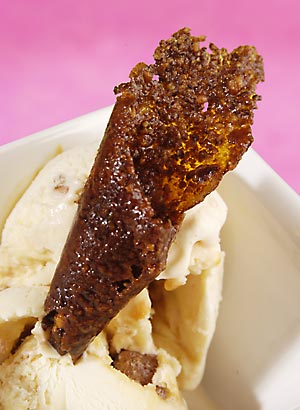
|
|
|
INGREDIENTS
|
1/2
cup butter
1 cup sugar
2 cups chopped pecans
2 tsp. Maple flavoring
|
|
MIXING
DIRECTIONS
|
Melt
butter over medium-high heat, add sugar
and pecans. Bring to boil, reduce heat
to medium-low and cook 7-8 minutes until
amber-colored. Stir occasionally. Remove
from heat and add 2 maple flavoring.
Pour onto greased foil and let cool.
Crumble.
|
|
|
PDF
Version
|

|

|

|
|
CLICK ON IMAGE FOR PDF VERSION OF CURRENT
LANDESRATFORUM NEWSLETTER |
|
Liebe
Leser im In- und Ausland, Freunde des Landesrates der
ungarndeutschen Chöre, Kapellen und Tanzgruppen auf aller
Welt!
2011 – 15 Jahre Landesrat, 10 Jahre LandesratForum.
Heute erhalten Sie das neue LandesratForum April 2011.
Ich hoffe das uns wieder Ihren Geschmack getroffen hat und ein
schönes Exemplar geworden ist . In diesem Jahr feiern wir
zwei Jubiläen, einmal 15 Jahre Landesrat und dann 10 Jahre
LandesratForum. Sollten Sie Ideen wie wir das feiern könnten,
oder wie wir das Forum besser und feierlicher gestalten könnten,
oder was wir hineinschreiben sollten, so bitte ich Sie teilen
Sie uns das alles mit. Wir freuen uns auf jede konstruktive
Kritik aber natürlich auch auf jede positive Meldung.
Ausserdem finden Sie Aufrufe, einer für das
HARMONIKALAGER einer für die Serie "FAMILIENMUSIK"
und ein weiterer für die TANZQUALIFIKATIONEN im Jahre 2011.
Auch in diesem Jahr sind wir wieder auf Ihre großzügige
Hilfe angewiesen. Unterstützen SIE uns bitte daher mit einer
Spende dass wir unseren Kulturauftrag auch weiterhin ausführen
können.
DAS LANDESRATFORUM IST KOSTENLOS - ABER NICHT UMSONST
|

|



VISITING
AUTHOR-ARTICLE
MARCH
2011

The
Lewis
Chessman
Forwarded
by Thomas B. Cole, M.D., MPH., JAMA
Page
649
JAMA, February 16, 2011—Vol
305, No. 7

THE
NORSE SEAFARERS OF THE MIDDLE AGES, ALSO
KNOWN as
the Vikings, explored Greenland and
North America, plundered
towns and monasteries along the coasts
of Europe, and established trade routes
throughout the western world. One of
their trade routes
stretched east by water from Norway to
the Gulf of Finland,
then overland and downriver through
present-day
Russia and across the Black Sea to
Constantinople, capital
of the Byzantine Empire. Another route
led to the Hebrides
Islands off the west coast of Scotland,
where a collection
of 93 game pieces of Norse origin was
found on the Isle of Lewis in 1831. Most
of the pawns were missing, but there
were almost enough face pieces to make
up four complete
chess sets. The pieces may have been
buried in the dunes by
a merchant or by a person of high rank
who hid the sets during
a time of conflict between local rulers
and their Norwegian
overlords.
Nine
of the Lewis chess pieces are displayed
on the cover. The
rounded arches of the helmets and
flowing, leafy scrollwork are
characteristic of the Romanesque style
of European art.
The chess pieces may have been carved in
Trondheim, the political and cultural
center of Norway at the time, using walrus
ivory from Greenland. The design of each
piece reflects its
status in medieval society and on the
field of play. The pawns, faceless
in this set, are analogous to vassals or
serfs. They are the
most numerous of the chess pieces but
have the least tactical value. Next in
importance are the knights on horseback,
most useful in the early phase of the
game when many pieces remain
in play, because they can leap over
other pieces to control
the center of the board and limit the
opponent's freedom of
movement. In the center of the group is
a bishop with his prayer
book and staff. Bishops are most
effective at the end of die
game, when fewer pieces remain on the
board to obstruct their
long diagonal movements.
To
either side of the bishop are the
warders, who defend the
fortifications. One of the two warders
is a berserker, a type
of specialist in Norse combat units who
would become
so enraged during battle that he would
bite his shield and
attack anyone within reach, whether
friend or foe. Some berserkers
led assaults and others served as
bodyguards. Instead
of warders, modern chess sets have
pieces that look like
castle towers, called rooks, to
symbolize their defensive role. Between
the pawns in the grouping on the cover sit
the king and the queen on their thrones.
In chess, if a king
is attacked and cannot escape, the game
is over. The steely
king on the cover grips his short sword
in both hands, as
if to say he will go down fighting. The
queen has more freedom
of movement, and is therefore more
dangerous, than all
of the other chess pieces; but
conversely, the loss of the queen
to an attacker is a severe handicap to
the player. No wonder
she looks so anxious and careworn.
As
the tactics of chess have evolved, the
style of play has often
reflected the social values of the
players. An early version
of chess was played in the Sassanid
Empire of Persia, perhaps as long ago as
600 CE. After the Muslim conquest of
Persia in the seventh century, chess
spread throughout the
Muslim world and via trade routes to
Christian Europe.
In the Middle Ages, chess was a popular
pastime of European
nobility, along with riding, archery,
hawking, and the
writing of verse, but players were
discouraged from spending
the time to become adept at chess,
because it was, after
all, only a game. In the Age of
Enlightenment, chess was
considered to be an exercise in moral
development; the American
author and political theorist Benjamin
Franklin wrote
that playing the game was a way to
acquire the virtues
of foresight, circumspection, and
caution.
By
the 19th century, chess had become an
everyman's game, with
more matches played in coffeehouses than
in palaces or landed
estates. Players with exceptional skill
emerged, and tactical
innovations were publicized in books and
journals. Chess masters
of the early 19th century were most
admired for their ability
to probe weaknesses in the opponent's
position. Players
typically used one or two pieces to
mount a quick attack on
the opposing king, without first taking
the time to move other
pieces into positions of support. To
counter these tactics,
more analytic players shored up their
defenses. In the 20th century,
combinations of moves were planned even
further ahead
to establish positional strength and
enable coordinated attacks. At
the expert level, the emphasis today is
on refining a winning strategy, rather
than on taking pride in a culturally
commendable or entertaining style.
Still, there is a place
for beauty in the choreography of chess.
Tacticians who specialize
in creating series of moves leading to
specific outcomes
are called chess composers, and their
compositions are played,
like musical scores, by students of the
game.

|
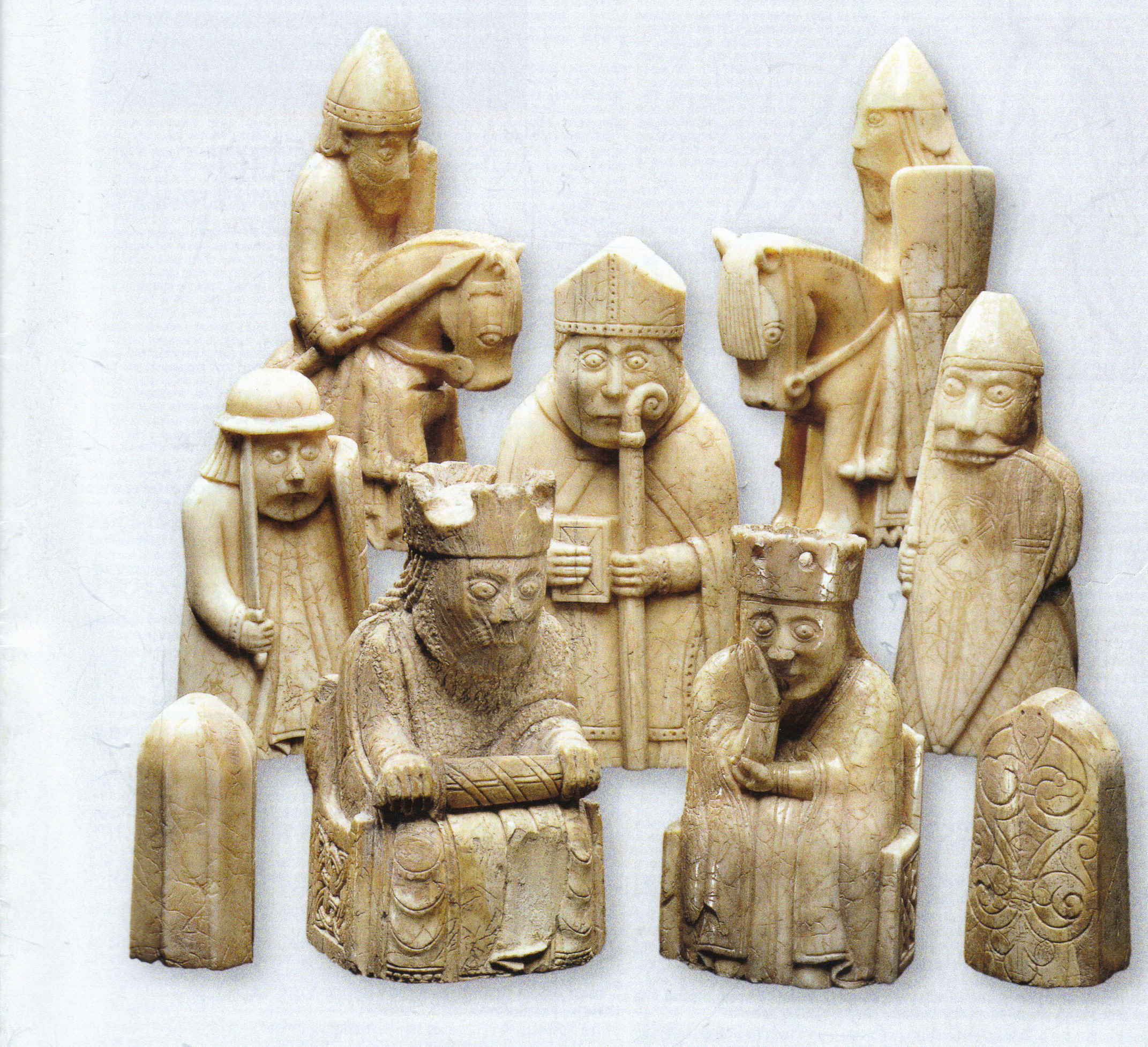
|
|
Courtesy
of The British Museum ( http://www.britishmuseum.org
), London, England.
©
The Trustees of the British
Museum
|
|
The Lewis Chessmen,
probably
made in Norway,
found on the Isle of Lewis,
Outer
Hebrides, Scotland,
circa 1150-1200.
Walrus ivory. Height: 4
to 10.3 cm.
|

Studying
and conserving the Lewis Chessmen
The hoard of 82 ivory chess-pieces
known as the Lewis Chessmen was found in
1831 in Uig on the Isle of Lewis in
the Outer Hebrides in what was
possibly a small, drystone
'subterranean' chamber.
The pieces consist of elaborately worked
walrus ivory and whales' teeth in the
forms of seated kings and queens, mitred
bishops, knights on their mounts,
standing warders and pawns in the shape
of obelisks.
When found, some were reported to be
stained red. Recent examination by
British Museum scientists and
conservators using optical microscopy
did suggest possible traces of red
coloration on some pieces, but
further investigation has not been
able to detect any colourants still
present.
Ivory is very similar to bone in
composition, consisting of a mixture of
organic and inorganic materials: the
inorganic part consists of calcium
phosphate in association with carbonate
and fluoride (hydroxyapatite). The
organic material is mainly the protein
ossein. Distinguishing between ivory and
bone, and determining the type of ivory
used requires expert examination using a
microscope.
Identification
of the ivory of the Lewis chessmen
Scientific examination of the Lewis
chessmen is ongoing, but recent investigations
at the British Museum have been focused
on identifying how they were shaped
and decorated, and what they are made
of.
Using a variable pressure scanning
electron microscope (SEM), scientists at
the Museum can see traces of wear and
modifications caused by burial and
damage.
Some of the chessmen are made from whale
tooth but most are made from walrus
ivory, the long upper canine teeth of
the Atlantic walrus. Teeth and tusks
have the same physical structures, which
consist of the innermost pulp cavity,
dentine, cementum and outermost enamel.
Walrus ivory structure consists of outer
hard yellowish-white enamel, cementum
and two distinct inner layers of
calcareous dentine. The image below
shows this unique structure: the
primary dentine has fine concentric
rings whereas the innermost core of
secondary dentine, which is spongy in
appearance but is as hard as the
primary, has a more globular texture,
sometimes described as marbled. The
original carvers have maximised the use
of the smoother primary dentine for the
carving.
Because of its colour, old walrus ivory
is reputed to be more valuable and
sought after for carving than fresh
material. The same structure is present
in both fresh and old walrus ivory; both
can be carved in the same way. SEM
examination shows that many of the
Lewis chessmen are made of old walrus
ivory. The ivory has been damaged
by marine gastropods, indicating the
walrus was long dead when the tusks were
collected.
Some of the chessmen are made from whale
tooth. Whales have conically shaped
teeth with a small amount of enamel at
the tips. The rest of the tooth is
covered by a substance called cementum.
The dentine is deposited in parallel
layers which shows up as concentric
rings.
The structure of walrus ivory (and whale
tooth) differs markedly from that of
elephant ivory. Polished cross-sections
of elephant ivory dentine display
uniquely characteristic Schreger lines,
often referred to as intersecting arcs
or engine-turnings.
|
The
underside of the king chessman
showing
the characteristic structure
of
walrus ivory in cross-section.
|

|
|
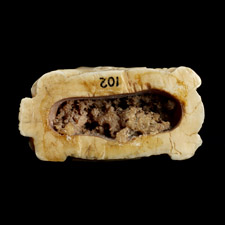
|
Traces
of old adhesive showing
on
the base of a knight chessman,
before
treatment.
|
| A
king chess-piece showing
breaks
between
the primary and secondary
dentine
|
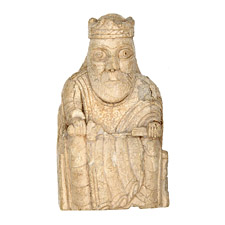
|
Conserving
the Lewis Chessmen
All the Lewis chessmen have recently
been examined by British Museum
conservators to investigate their
condition and carry out any treatment
required for them to be safely
displayed.
Some of them have undergone minor
conservation treatments over the years
since their discovery to stabilise them
but on the whole are in relatively good
condition. In some cases these old
coatings and adhesives had changed with
time and become more noticeable or had
degraded leaving unsightly remains
visible on the surface.
Ultraviolet light was used to reveal
further evidence of old treatments not
visible in normal light. The materials
used in these previous treatments have
been characterised and documented, and
provide an insight into changing
approaches to the selection of
conservation materials over the last
century.
Walrus ivory has a distinctive structure
with two distinct inner layers of
dentine, which affects the way in which
it deteriorates and this in turn affects
the approach to its conservation. In a
few cases there was evidence of old
movement such as cracks and breaks
between the primary and secondary
dentine.
Light cleaning and some stabilization
was needed. Splits and cracks were treated
with a dilute adhesive and areas of loss
filled. Only adhesives and fill
materials stable, reversible and also
flexible enough to accommodate slight size
changes in the ivory, were used.
As
a very sensitive material, prolonged
exposure to water can leave ivory
brittle and chalky, while acids
readily attack it. It also reacts to
changes in the moisture content of the
air. If the humidity in the
environment drops, the ivory loses
moisture and contracts. If the humidity
increases, it absorbs moisture and
expands. Fluctuations in humidity (or
exposure to heat) can cause ivory to
crack, split or warp, so the chessmen
are kept in a stable environment of
about 40-55% Relative Humidity and at a
temperature of 16-20 ºC.
It is likely that some of the chessmen
were once coloured although analysis has
not been able to detect any colouring
agents still present. Nevertheless,
since some colourants are light
sensitive, the lighting within the
display-case is kept at a low level, so
any remaining colour will be preserved.

|
|
|

|